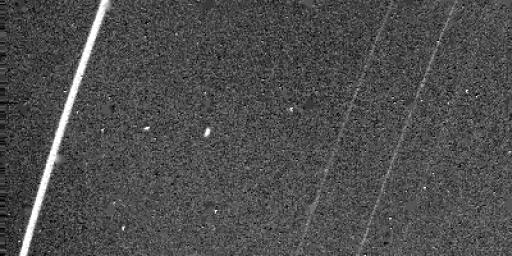
|
Rings of Uranus at 1.44 kilometers
- Click the image above for a larger view
- Full-Res JPEG (400 x 200) (28.9 kB)
- Full-Res TIFF (400 x 200) (23.9 kB)
Caption:
The outer rings of Uranus are visible in this Voyager 2 image, obtained Jan. 23, 1986, from a distance of 1.44 million kilometers (890,000 miles). The outermost and brightest ring, called epsilon, is visible along with the fainter and narrower delta and gamma rings (from left). This clear-filter, 15-second exposure was shuttered by Voyager's narrow-angle camera. The resolution of this image is about 15 km (9 mi). The epsilon ring is resolved into two bright components separated by a darker lane of material. Voyager scientists believe this is caused by a thinning of the ring material away from the edges of the ring. This image was part of a sequence of pictures designed to search for moons orbiting within the rings and responsible for their narrow appearance. One of two such "shepherd" moons discovered by Voyager -- found Jan. 20 and designated 1986U7 -- is visible as the elongated bright feature midway between the epsilon and delta rings. The moon appears elongated because its orbital motion smeared its image during the long exposure.
Background Info:
The Voyager project is managed for NASA by the Jet Propulsion Laboratory.
Cataloging Keywords:
| Name | Value | Additional Values |
|---|---|---|
| Target | Uranus Rings | Delta Ring, Epsilon Ring, Gamma Ring, Uranus |
| System | Uranus | |
| Target Type | Ring | Planet |
| Mission | Voyager | |
| Instrument Host | Cassini Orbiter | Voyager 2 |
| Host Type | Orbiter | Flyby Spacecraft |
| Instrument | Imaging Science Subsystem (ISS) | |
| Detector | Narrow Angle Camera | |
| Extra Keywords | Grayscale, Visual | |
| Acquisition Date | ||
| Release Date | 1998-11-11 | |
| Date in Caption | 1986-01-23 | |
| Image Credit | NASA/JPL | |
| Source | photojournal.jpl.nasa.gov/catalog/PIA01350 | |
| Identifier | PIA01350 | |
